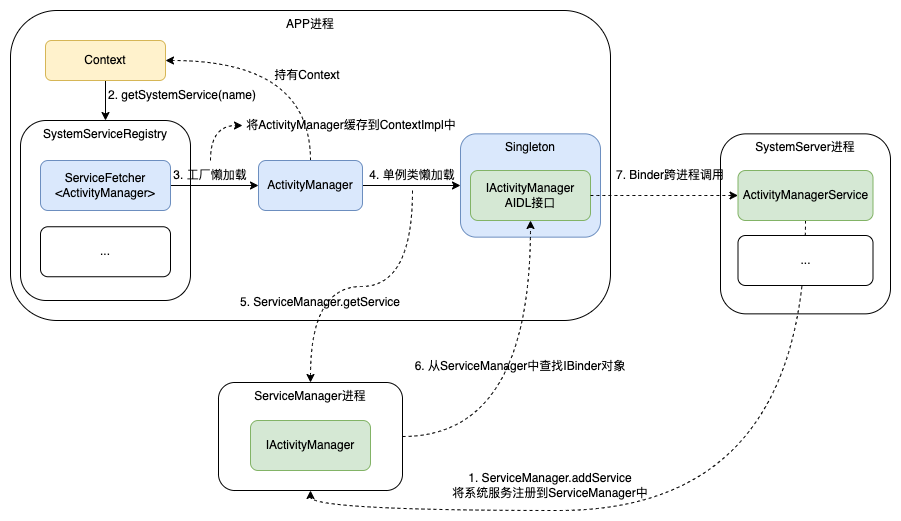应用和系统服务跨进程通信
App运行过程中经常会与系统服务通信。当客户端要跨进程调用AMS、WMS等方法时,需要先获取系统服务的IBinder代理对象。
例如
context.getSystemService(Context.ACTIVITY_SERVICE)获取ActivityManager对象context.getSystemService(Context.WINDOW_SERVICE)获取WindowManager对象
本篇介绍应用跨进程调用系统服务方法的原理:
以ActivityManager为例
- SystemServer进程启动时调用
ServiceManager.addService将系统服务注册到ServiceManager进程中 - APP进程启动时,将系统服务的工厂类注册到
SystemServiceRegistry中,使用Map存储 - APP调用
context.getSystemService查找到工厂类,使用工厂类创建ActivityManager对象,并缓存到ContextImpl中 - ActivityManager通过
ServiceManager查找IBinder对象,通过IActivityManager跨进程调用AMS方法
源码分析
ContextImpl#getSystemService
Context具体实现类是ContextImpl
//ContextImpl.java
@Override
public Object getSystemService(String name) {
...
//从SystemServiceRegistry仓库中获取对象,传入Context
return SystemServiceRegistry.getSystemService(this, name);
}
SystemServiceRegistry
- 保存服务名称和服务工厂到Map中,用到的时候再加载(懒加载服务)
- 根据服务名称查找到服务工厂,使用工厂创建服务对象,并缓存到ContextImpl中
public final class SystemServiceRegistry {
private static final Map<String, ServiceFetcher<?>> SYSTEM_SERVICE_FETCHERS = new ArrayMap<String, ServiceFetcher<?>>();
private static int sServiceCacheSize;
static {
//注册ActivityManager服务,传入工厂对象
registerService(Context.ACTIVITY_SERVICE, ActivityManager.class, new CachedServiceFetcher<ActivityManager>() {
@Override
public ActivityManager createService(ContextImpl ctx) {
return new ActivityManager(ctx.getOuterContext(), ctx.mMainThread.getHandler());
}});
//注册WindowManager服务
registerService(Context.WINDOW_SERVICE, WindowManager.class, new CachedServiceFetcher<WindowManager>() {
@Override
public WindowManager createService(ContextImpl ctx) {
return new WindowManagerImpl(ctx);
}});
...
}
//注册服务工厂,保存到Map中
private static <T> void registerService(@NonNull String serviceName,
@NonNull Class<T> serviceClass, @NonNull ServiceFetcher<T> serviceFetcher) {
SYSTEM_SERVICE_FETCHERS.put(serviceName, serviceFetcher);
}
//获取服务
public static Object getSystemService(ContextImpl ctx, String name) {
//获取服务的工厂对象
final ServiceFetcher<?> fetcher = SYSTEM_SERVICE_FETCHERS.get(name);
...
//从工厂中获取服务对象,如果已创建,则从缓存中获取
final Object ret = fetcher.getService(ctx);
return ret;
}
}
CachedServiceFetcher
- ContextImpl中缓存服务对象数组
- 工厂类首先从ContextImpl中查找服务,如果没有,则创建对象并缓存到ContextImpl中
- 每个Context独立使用一个ActivityManager对象
//ContextImpl.java
class ContextImpl extends Context {
//Context缓存服务对象
final Object[] mServiceCache = SystemServiceRegistry.createServiceCache();
}
//SystemServiceRegistry.java
static abstract class CachedServiceFetcher<T> implements ServiceFetcher<T> {
//保存索引
private final int mCacheIndex;
CachedServiceFetcher() {
mCacheIndex = sServiceCacheSize++;
}
//伪代码
@Override
public final T getService(ContextImpl ctx) {
//从缓存中查找
final Object[] cache = ctx.mServiceCache;
...
T service = (T) cache[mCacheIndex];
if(service != null) {
return service;
}
//如果没有缓存则创建
service = createService(ctx);
//保存到Context中
cache[mCacheIndex] = service;
}
}
ActivityManager和IActivityManager
getSystemService拿到的ActivityManager是一个包装类,真正跨进程通信的是IActivityManager对象。
IActivityManager是Framewrok中定义的AIDL接口,是一个IBinder对象,即服务端在客户端的代理对象。
public class ActivityManager {
//单例类,实现懒加载
private static final Singleton<IActivityManager> IActivityManagerSingleton =
new Singleton<IActivityManager>() {
@Override
protected IActivityManager create() {
//从ServiceManager中获取IBinder对象
final IBinder b = ServiceManager.getService(Context.ACTIVITY_SERVICE);
final IActivityManager am = IActivityManager.Stub.asInterface(b);
return am;
}
};
//通过IActivityManager跨进程通信
public static IActivityManager getService() {
return IActivityManagerSingleton.get();
}
}
ServiceManager
public final class ServiceManager {
@UnsupportedAppUsage
private static IServiceManager sServiceManager;
private static Map<String, IBinder> sCache = new ArrayMap<String, IBinder>();
private static IServiceManager getIServiceManager() {
if (sServiceManager != null) {
return sServiceManager;
}
//获取IBinder对象IServiceManager
sServiceManager = ServiceManagerNative.asInterface(Binder.allowBlocking(
// native方法,返回Binder驱动的上下文对象,句柄为0
// ServiceManager进程启动的时候会将自身注册为Binder驱动的上下文对象
BinderInternal.getContextObject()
));
return sServiceManager;
}
public static void addService(String name, IBinder service, boolean allowIsolated,
int dumpPriority) {
try {
//将系统服务注册到ServiceManager中
getIServiceManager().addService(name, service, allowIsolated, dumpPriority);
} catch (RemoteException e) {
Log.e(TAG, "error in addService", e);
}
}
public static IBinder getService(String name) {
try {
//从缓存中获取
IBinder service = sCache.get(name);
if (service != null) {
return service;
} else {
//从ServiceManager中获取
return Binder.allowBlocking(rawGetService(name));
}
} catch (RemoteException e) {
Log.e(TAG, "error in getService", e);
}
return null;
}
private static IBinder rawGetService(String name) throws RemoteException {
//从ServiceManager中获取系统服务的IBinder对象
final IBinder binder = getIServiceManager().getService(name);
...
return binder;
}
}
源码设计思想
为什么IActivityManager使用单例类存储?
IActivityManager是AMS的代理对象,用于跨进程调用,每个进程只需要一个实例即可,因此IBinder对象设计成单例
为什么开发者不能直接使用IActivityManager进行跨进程通信,而要通过ActivityManager包装类访问?
IActivityManager是AIDL接口,跟随系统源码编译,不在SDK源码中,开发者无法直接使用- ActivityManager中持有Context,并且封装了一些额外的逻辑,如果开发者直接使用AIDL接口,则需要自行封装,填入多个参数
- AIDL方法调用需要
try-catch(RemoteException),在ActivityManager中完成,避免开发者手写
为什么SystemServiceRegistry保存的是一个工厂ServiceFetcher,而不是ActivityManager对象?
- 实现ActivityManager懒加载:进程启动的时候只初始化工厂对象,直接初始化ActivityManager代价较大
- 使用工厂可以创建多次ActivityManager对象,如果直接保存ActivityManager对象,则整个进程只能共用一个
为什么通过Context获取ActivityManager,而不直接调用SystemServiceRegistry?
- ActivityManager中会用到Context,即需要和Context绑定,由于存在多个Context,因此也需要多个ActivityManager对象。
- 同一个Context共用一个ActivityManager,避免拿到工厂对象后,重复创建ActivityManager对象。
为什么将ActivityManager缓存到Context中?是否可以缓存到一个Map<Context, Object[]>中?
- 同一个Context共用一个ActivityManager
- Context回收,ActivityManager也会释放。如果缓存到Map中则无法释放


